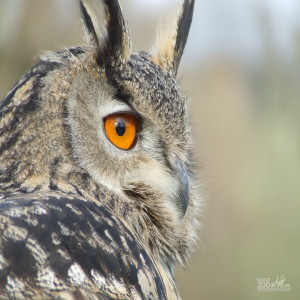 The Eurasian Eagle-Owl is a species of eagle-owl that resides in much of Eurasia. It is one of the largest species of owl, and females can grow to a total body length of 30 in, with a wingspan of 4 ft 4 in to 6 ft 2 in. Males are slightly smaller. Females can weigh from 3.9 to 10.1 pounds and males can weigh from 2.7 to 7.1 pounds. This bird has distinctive ear tufts, with upper parts that are mottled with darker blackish coloring and tawny. The wings and tail are barred. The under parts are a variably hued buff, streaked with darker color. The facial disc is poorly developed and the orange eyes are distinctive. Besides the female being slightly larger than the male there is little external differentiation between them. The great size, bulky, barrel-shaped build, erect ear tufts and orange eyes render this as a distinctive species.
The Eurasian Eagle-Owl is a species of eagle-owl that resides in much of Eurasia. It is one of the largest species of owl, and females can grow to a total body length of 30 in, with a wingspan of 4 ft 4 in to 6 ft 2 in. Males are slightly smaller. Females can weigh from 3.9 to 10.1 pounds and males can weigh from 2.7 to 7.1 pounds. This bird has distinctive ear tufts, with upper parts that are mottled with darker blackish coloring and tawny. The wings and tail are barred. The under parts are a variably hued buff, streaked with darker color. The facial disc is poorly developed and the orange eyes are distinctive. Besides the female being slightly larger than the male there is little external differentiation between them. The great size, bulky, barrel-shaped build, erect ear tufts and orange eyes render this as a distinctive species.
Location: Education Animals
Share:
Range
The Eurasian Eagle-Owl is one of the most widely distributed species of owl and is found in England and Western Europe from Spain towards the Russian coast and throughout Asia.
Habitat
This owl is distributed sparsely and found in many habitats. They are partial to irregular topography. It is mostly a bird of mountain regions, coniferous forests, steppes and other relatively remote places.
Conservation Status
Least Concern
Primary Threats
Gestation
The eggs are normally laid at intervals of 1 to 3 days and incubated only by the female. The first egg usually hatches after 31 to 36 days, and the remaining eggs hatching at intervals of 1-2 days.
Litter
Typically two eggs at intervals (See Gestation)
Behavior
It is a mostly nocturnal predator, hunting for a range of different prey species.
Reproduction
In Spain incubation is from mid-January to mid-March, hatching and early nestling period from late March to early April, Fledgling period mid-April to August. In more eastern countries the times are slightly later.
Wild Diet
Small mammals, birds of varying sizes, reptiles, amphibians, fish, large insects and other assorted invertebrates
Zoo Diet

